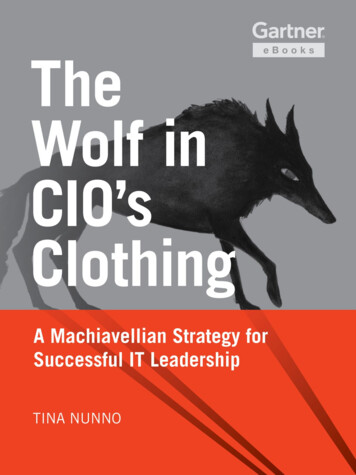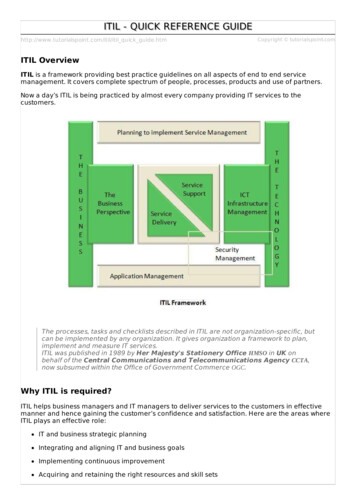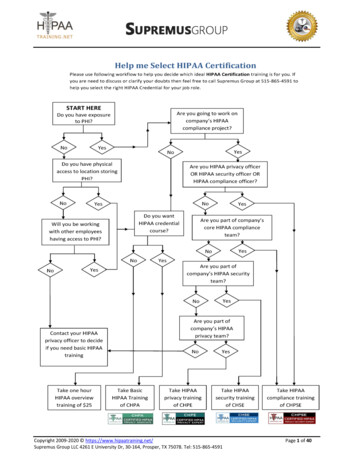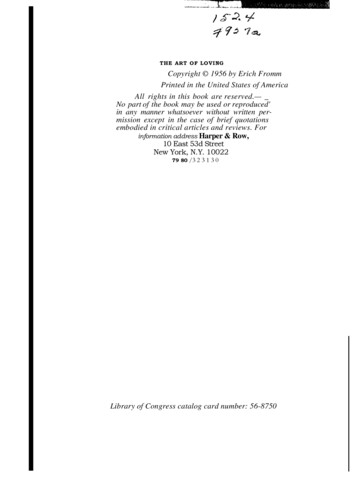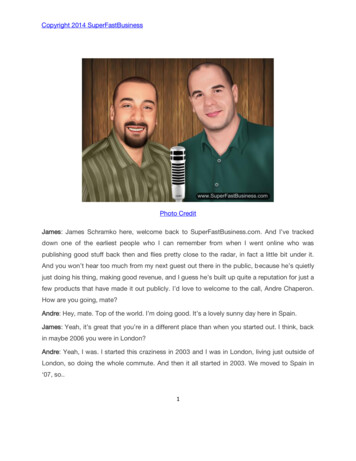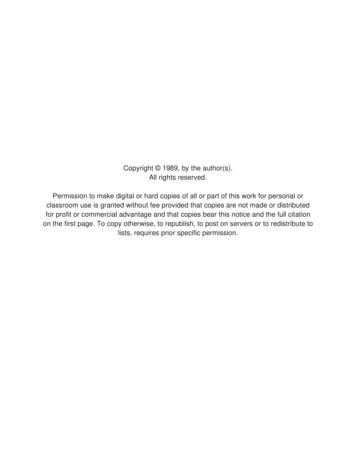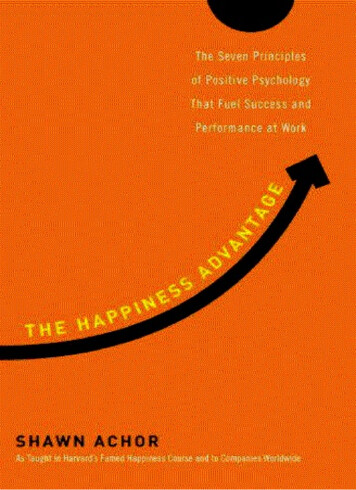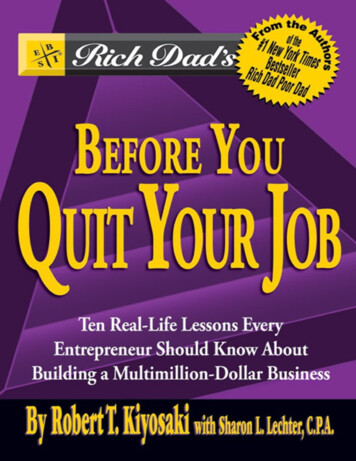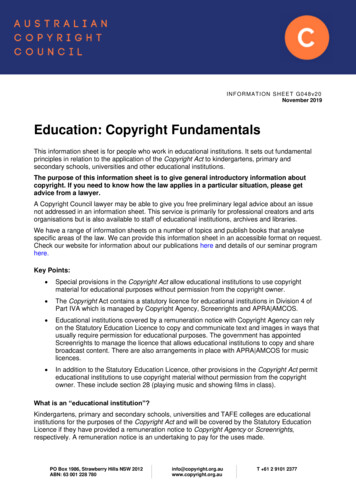
Transcription
INFORMATION SHEET G048v20November 2019Education: Copyright FundamentalsThis information sheet is for people who work in educational institutions. It sets out fundamentalprinciples in relation to the application of the Copyright Act to kindergartens, primary andsecondary schools, universities and other educational institutions.The purpose of this information sheet is to give general introductory information aboutcopyright. If you need to know how the law applies in a particular situation, please getadvice from a lawyer.A Copyright Council lawyer may be able to give you free preliminary legal advice about an issuenot addressed in an information sheet. This service is primarily for professional creators and artsorganisations but is also available to staff of educational institutions, archives and libraries.We have a range of information sheets on a number of topics and publish books that analysespecific areas of the law. We can provide this information sheet in an accessible format on request.Check our website for information about our publications here and details of our seminar programhere.Key Points: Special provisions in the Copyright Act allow educational institutions to use copyrightmaterial for educational purposes without permission from the copyright owner. The Copyright Act contains a statutory licence for educational institutions in Division 4 ofPart IVA which is managed by Copyright Agency, Screenrights and APRA AMCOS. Educational institutions covered by a remuneration notice with Copyright Agency can relyon the Statutory Education Licence to copy and communicate text and images in ways thatusually require permission for educational purposes. The government has appointedScreenrights to manage the licence that allows educational institutions to copy and sharebroadcast content. There are also arrangements in place with APRA AMCOS for musiclicences. In addition to the Statutory Education Licence, other provisions in the Copyright Act permiteducational institutions to use copyright material without permission from the copyrightowner. These include section 28 (playing music and showing films in class).What is an “educational institution”?Kindergartens, primary and secondary schools, universities and TAFE colleges are educationalinstitutions for the purposes of the Copyright Act and will be covered by the Statutory EducationLicence if they have provided a remuneration notice to Copyright Agency or Screenrights,respectively. A remuneration notice is an undertaking to pay for the uses made.PO Box 1986, Strawberry Hills NSW 2012ABN: 63 001 228 780info@copyright.org.auwww.copyright.org.auT 61 2 9101 2377
Australian Copyright Council Information Sheet G048v20 Education: Copyright Fundamentals2Other organisations that provide training (whether registered as a training organisation ornot) can also be an educational institution, such as an institution with the principal function ofproviding courses of study or training for the teaching of English to people whose first language isnot English. In some cases, they will need to follow certain procedures before they are entitled torely on the provisions available to educational institutions in the Copyright Act.There are no general exemptions from copyright law for non-profit organisations, therefore each ofthe educational exceptions needs to be considered individually in order to determine whether itapplies to a for-profit organisation.A cultural organisation that provides outreach programmes to primary and/or secondary schoolsmay not be an “educational institution” for the purposes of the Copyright Act, but may usematerials for educational purposes or provide educational instruction.For further details see ducational-licences/ (inrelation to text, music and notated music), ces/educational-licence (in relation to broadcast material) -types/music-in-education/ (in relation to musicin education).The Statutory Education LicenceCopying and communicating text, images and notated musicThe Statutory Education Licence allows educational institutions covered by a remuneration noticewith Copyright Agency to copy and communicate text, images and notated music for educationalpurposes up to certain limits. Not only can educational institutions make hard copies of material fortheir students, they can also upload the material to a secured shared drive or learningmanagement system or email the material to students directly.In most cases, the amount that can be copied and communicated is limited to a reasonable portion(e.g. 10% or 1 chapter) if the work is available for purchase. A specific notice must be includedwith digital copies and communications.If a copy is sold, or used for a purpose other than education, it is deemed to be an infringing copy.Copying and communicating material from television and radioThe Statutory Education Licence allows educational institutions covered by a remuneration noticewith Screenrights to record from radio and TV for educational purposes and to copy andcommunicate those recordings. It allows for an entire program to be recorded and copied, even ifyou can buy that program (on DVD, for example). Certain information must be displayed onanalogue recordings and copies and with communications of recorded programs.The Statutory Education Licence only applies to audio visual material sourced from a broadcast orradio. It does not apply to purchased, rented or borrowed DVDs or videos. Nor does it apply tostreaming platforms, a digital download or a podcast unless it is a program that has been shown asa free-to-air broadcast and has been made available online by the official broadcaster (e.g. on theABC website).If a copy is sold, or used for a purpose other than education, it is deemed to be an infringing copy.PO Box 1986, Strawberry Hills NSW 2012ABN: 63 001 228 780info@copyright.org.auwww.copyright.org.auT 61 2 9101 2377
Australian Copyright Council Information Sheet G048v20 Education: Copyright Fundamentals3Exceptions relevant to educationCertain provisions in the Copyright Act allow: educational institutions (without payment to copyright owners) to play music and screen films inclass: section 28. This provision also allows non-infringing content to be directly streamed fromwebsites in class unless you have contractually agreed not to do so; copying by students for their research or study: section 40; the reading or recitation in public of an extract of reasonable length from a published literary ordramatic work where sufficient acknowledgement of the work is made: section 45; copying by hand (e.g. on a whiteboard) in the course of educational instruction: section 200(1); copying and communicating in connection with exams: section 200(1A); the making of a record of a sound broadcast intended to be used for educational purposes ifthe record is not used except in the course of instruction at that place and the record is madeby the authority in charge of a place of education that is not conducted for profit: section200(2); and the making of a record of a sound broadcast if the record is made by the body administering aneducational institution and the recording is only used for the educational purposes of thatinstitution: section 200(2)(a).Section 200AB: the special case or flexible dealing exceptionSection 200AB allows an educational institution to use copyright material for educationalinstruction in certain cases where the use is not covered by other specific exceptions in theCopyright Act. It does not apply to a use that would be covered by the statutory licence or the otherprovisions relevant to educational institutions.Section 200AB only applies if: the circumstances of the use amount to a special case; the use does not conflict with a normal exploitation of the material; the use does not unreasonably prejudice the legitimate interests of the owner of the copyright;and the copying is not made for commercial advantage or profit (cost recovery is allowed if it doesnot exceed the costs of the use to the charger of the fee).Section 200AB is more complex than other exceptions in the Copyright Act, and you will usuallyneed advice about whether or not it applies in a particular situation.For more information, see our information sheet Section 200AB: The Special Case or FlexibleDealing ExceptionEducational licences with the music industry collecting societiesSome educational institutions are covered by licence agreements with the music industry collectingsocieties. The licence agreements allow the institution to use music in ways that are not coveredby the special exceptions in the Copyright Act.The music industry collecting societies are APRA AMCOS (www.apraamcos.com.au), ARIA(www.aria.com.au) and PPCA (www.ppca.com.au).OneMusic Australia has licences for dance schools, see information available athttps://onemusic.com.au/licences/.PO Box 1986, Strawberry Hills NSW 2012ABN: 63 001 228 780info@copyright.org.auwww.copyright.org.auT 61 2 9101 2377
Australian Copyright Council Information Sheet G048v20 Education: Copyright Fundamentals4Primary and secondary schoolsAll government schools are covered by the licences set out below. Most other primary andsecondary schools are also covered by these licences: check with your peak organisation if youare unsure. APRA Performance Licence: performance of music (outside a class) AMCOS Print Music Licence: making photocopies and transcriptions of print music APRA AMCOS ARIA Music Recordings and Access (A/V) Licence: recording/copying musicand sound recordings.For further details see the APRA AMCOS website: c-in-education/schools/.UniversitiesIn 2005, Universities Australia entered into an agreement with APRA, AMCOS, ARIA and PPCA tocover its universities for the majority of their music uses. Activities covered by the agreementinclude making audio and video recordings for use at university events, of university events and foreducational purposes (i.e. activities associated with a particular course of study or research) andmaking music available via a password-protected and login-protected intranet site. Some music isexcluded from the licence and there are conditions for some of the uses.For further details contact your university’s copyright officer or Universities Australia and see theAPRA AMCOS website: ic-ineducation/universities/.Further information and adviceA Copyright Council lawyer may be able to give you free preliminary legal advice about an issuenot addressed in an information sheet. This service is primarily for professional creators and artsorganisations but is also available to staff of educational institutions and libraries. For furtherinformation about the service, see the Legal Advice section of our website copyright.org.au.You may also be interested in the information for schools prepared by the National Copyright Unitfor schools and TAFE at smartcopying.edu.au.APRA AMCOS has produced the Guide to Music Copyright for Australian Educators which isavailable at print-music final.pdf.Reproducing this information sheetOur information sheets are regularly updated. Please check our website to ensure you areaccessing the most current version. Should you wish to use this information sheet for anypurpose other than your reference, please contact us for assistance.About usThe Australian Copyright Council is an independent, non-profit organisation. Founded in 1968, werepresent the peak bodies for professional artists and content creators working in Australia’screative industries and Australia’s major copyright collecting societies.We are advocates for the contribution of creators to Australia’s culture and economy; theimportance of copyright for the common good. We work to promote understanding of copyright lawPO Box 1986, Strawberry Hills NSW 2012ABN: 63 001 228 780info@copyright.org.auwww.copyright.org.auT 61 2 9101 2377
Australian Copyright Council Information Sheet G048v20 Education: Copyright Fundamentals5and its application, lobby for appropriate law reform and foster collaboration between contentcreators and consumers.We provide easily accessible and affordable practical, user-friendly information, legal adviceeducation and forums on Australian copyright law for content creators and consumers.Australian Copyright Council respectfully acknowledges the Gadigal people, the owners andcustodians of the land on which our office is located. We pay our respects to the elders and to allFirst Nations elders: past, present and emerging. This always was and always will be Aboriginalland.The Australian Copyright Council has been assisted by theAustralian Government through the Australia Council, itsarts funding and advisory body. Australian Copyright Council 2019PO Box 1986, Strawberry Hills NSW 2012ABN: 63 001 228 780info@copyright.org.auwww.copyright.org.auT 61 2 9101 2377
Primary and secondary schools All government schools are covered by the licences set out below. Most other primary and secondary schools are also covered by these licences: check with your peak organisation if you are unsure. APRA Performance Licence



